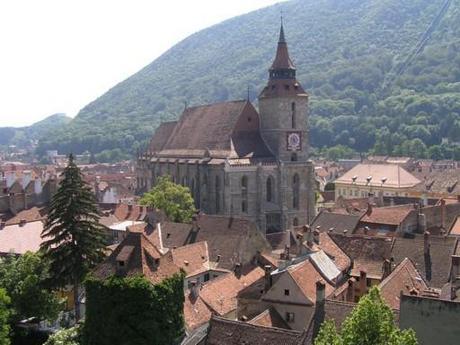The Black Church
Brasov's most important landmark, the Black Church, the largest Gothic church between Vienna and Istanbul, towers over Piata Sfatului and the old town. Originally dedicated to Virgin Marry the church was Roman-Catholic for more than a century and a half and later with the reformation sweeping across Europe it became a Lutheran one. Service is still held today for the small German community from Brasov on Sundays. The Black Church boasts the largest church bell in Romania, weighing in at seven tons.
Built between 1385 and 1477 on the site of an earlier church (destroyed by Mongol invasions in 1242), the construction of the Marienkirche, as it was known in German, was hampered by extensive damage caused by Turkish raids in 1421. The church was given its new name after disaster struck again in 1689, when the Great Fire leveled most of the town, blackening the walls of the church. Restoration took almost 100 years. Of two towers planned, only one was finished. The Black Church is the largest gothic church between Vienna and Istanbul.
The Black Church has a turbulent history: built between 1385 and 1477 on the site of an earlier church (destroyed by Mongol invasions in 1242), the construction of the Marienkirche was hampered by extensive damage caused by Turkish raids in 1421. The church was given its new name after disaster struck again in 1689, when the 'Great Fire, set by Hapsburg invaders, leveled most of the town, heavily damaged the church, blackening its walls. Restoration took almost 100 years. Of the two towers planned, only one (65,6m high) was finished. The year 1477 is written in Gothic letters on the front gate, the only piece made in wood that resisted the fire. The original Gothic interior has suffered under the restorations, and the lofty, light space you see nowadays is mostly Baroque. Most of the objects inside the church date from the reconstruction time except for the baptismal font which was cast in bronze by a local craftsman in 1450.
The church is built of friable grit stones and andesite arranged in cubic shape. That's the reason why the statues placed on the exteriors couldn't survive the time and had to be replaced by new ones. The oldest statue still standing belongs to Saint Peter and it is to be seen on the Southern part of the church.
The church comprises six portals, representing different architectural styles from Gothic to Renaissance style. The portal placed on the East side of the church was built in 1436 by Matei Corvin, a Transylvanian ruler. He also added a fresco to the interior gate. Inside the church there are three naves split by pillars. Gothic elements mix with Baroque.
On the Southeast portal there is a fresco, dating 15th century, representing Saint Mary sitting on a throne with Jesus in her arms, surrounded by angels and Saint Ecaterina and Barbara. On the North side there is a Golden gate with a small portico placed somewhere between the buttresses. The portico is covered by a simple ogive and on the facade there is a semicircular arch. Right above there are sculptured leaves, reminiscence of the Gothic style. The Black Church exhibits the heaviest mobile bell in Romania (6 t), murals in the Italian Renaissance style and an organ, with 4,000 pipes, 7 scales and 4 key boards. It was built in 1838-1839 by the organ creator Buchholz from Berlin and it ranks among the biggest organs in the South-Eastern Europe. It is the only organ of the Buchholz's firm which has preserved its original form. The organ recitals held here are very famous and many tourists attend them.
The Black Church has the richest collection of Anatolian carpets in all Europe. Most of them date from the 17th and 18th centuries. They come from Brussa, Uschak and Ghiordes, famous Anatolian names for carpet weaving. They were donated by the city's merchants on their return from Orient to show their gratitude towards God. The church windows have recently been fit out with special UV-filtering glass to protect the 119 fabulous carpets.
Exiting the church, in the courtyard, you will see Johannes Honterus'(1498-1549) statue (2.5 m high). He was an important reformer and humanist who became Stadtpfarrer (priest) a few years after bringing Lutheranism to Brasov in 1542. The statue was cast in bronze by the German sculpture, Harra Magnussen. The public saw the statue for the first time on August 1898, when they celebrated 400 years since Johannes Honterus was born.
The original gothic interior got a makeover during restorations, and the lofty, light space you see today is mostly baroque. The interior is beautiful, with balconies, stained glass windows, an enormous organ, stone columns and walls adorned with fabulous Turkish carpets. The church windows have recently been fitted out with special UV-filtering glass to protect the 119 Anatolian carpets. Thankful to have survived their trips into the "barbaric" lands south and east of the Carpathians, German merchants donated the carpets to the church in the 17th and 18th centuries. The collection is the largest of its kind in Europe.
Listen to the impressive 4,000-pipe organ dating from 1839 during concerts held here three times a week in the summer.




